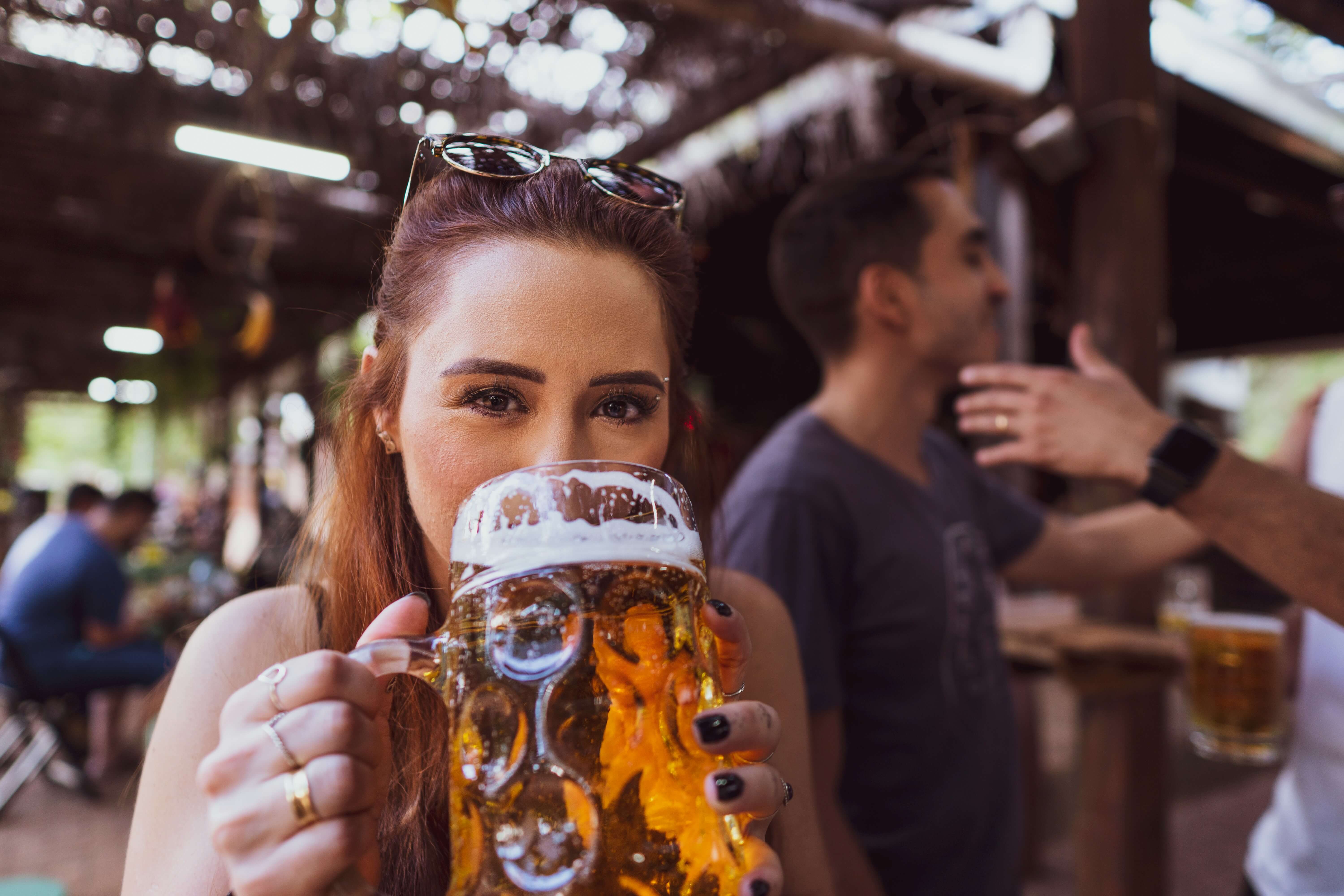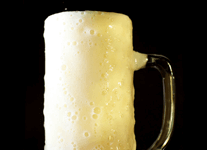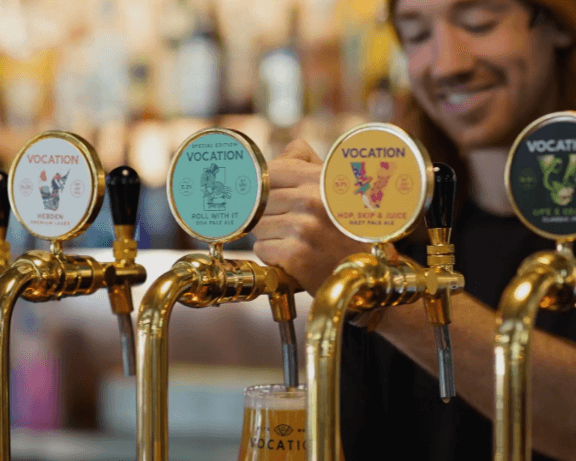
The brewing team has worked their behinds off designing recipes, buying ingredients, shoveling spent grain and babysitting temperatures all so that we can enjoy a flawless product. Yet, all that hard work would go down the proverbial and literal drain if, at the last second, it hasn’t been served properly. A great brewery taproom has trained their team how a beer should be served so let’s go over how they make sure they don’t rile the brewer.
How to Pour the Perfect Pint in 4 Easy Steps
Jump to Section:
- Rule 1: Clean Beer Glass
- Rule 2: Proper Serving Temperature
- Rule 3: Proper Glassware
- Rule 4: The Perfect Pour
Rule 1: Clean Beer Glass
We drink with our eyes first, believe it or not. And it won’t matter if you’ve got the temperature down to the millidegree or if you’re using the finest crystal glass in all the land: if the glass is not “beer clean” it won’t look the way it should.
You’ll know a glass isn’t “beer clean” if you see bubbles sticking to the side of the glass or the head isn’t stable; that means that there’s either some dust or detergent residue stuck to the inside (chances of it being dirty dirty are slim unless you’re in a real dive). A glass that isn’t beer-clean can also affect mouthfeel and flavour. Say it ain’t so!
A quick rinse with some water—that’s what you’re seeing when the bartender rinses out your glasses before pouring your beer—ensures that any undesirables are washed away. If you’ve had this problem with your first glass, a discrete and polite request for the bartender to rinse out your next glass before serving is perfectly ok. A few drops of water won’t affect your beer.
Rule 2: Proper Serving Temperature
You’ve got a crystal clear clean beer glass and you’re ready to roll. The next most important thing to make sure you can enjoy a beer in all its glory is serving it at the proper serving temperature required for its style. Too cold for some styles and you’ll miss all the subtle flavours, too warm for others and its crisp character will be lost. There is a “just right” for each style—just follow our handy chart below:
| Beer Style | Serving Temperature |
|---|---|
| American IPA | 7-10C |
| English IPA | 4-7C |
| Imperial/Double IPA | 10-13C |
| American Pale Ale | 4-7C |
| English Bitter/English Pale Ale | 7-10C |
| Belgian Pale Ale | 7-10C |
| Saison | 7-10C |
| Belgian Dubbel | 7-10C |
| Belgian Tripel | 7-10C |
| Belgian Quadrupel | 10-13C |
| Witbier | 7-10C |
| Weissbier/Hefeweizen | 7-10C |
| Altbier | 7-10C |
| Kölsch | 4-7C |
| English Porter | 10-13C |
| American Porter | 7-10C |
| Stout | 10-13C |
| Oatmeal/Milk/Sweet Stout | 10-13C |
| Russian Imperial Stout | 10-13C |
| Barleywine | 10-13C |
| Wee Heavy/Scotch Ale | 7-10C |
| American Amber/Red Lager | 4-7C |
| California Common/Steam Beer | 4-7C |
| Czech/Bohemian Pilsner | 4-7C |
| German Pilsener | 4-7C |
| Bock/Doppelbock/Maibock | 7-10C |
| Munich Helles | 4-7C |
| German Pilsener | 4-7C |
| Märzen/Oktoberfest | 7-10C |
| Rauchbier | 10-13C |
| Gose | 7-10C |
| Berliner Weisse | 7-10C |
| Gueuze | 10-13C |
| Fruit Lambic | 7-10C |
Rule 3: Proper Glassware
This next rule is a general guideline to get the most out of your chosen beer. While, admittedly, a good bit of choosing the proper glassware is mostly to make us feel better there is some logic behind it all. Certain styles—like Weissbiers or Pilsners—have a lovely big head. The shape of their requisite glasses supports the head allowing it to stand tall (and maybe even have you get a bit of it on your nose). Other styles, like a Barleywine or a Wee Heavy would do well in a snifter as the curved lip concentrates some of the aromas bring them closer to your nose. Below are some common glass types and the styles best suited for them:
Pint Glass
This classic glass has a few variants: Nonic (20 Imp Fl Oz.), Shaker (used often in the US--16 US Fl Oz.) or Tulip (common in the UK).
Good for:
Almost all American styles: Pale Ales, Amber Ales, IPAs, Stouts, Brown Ales, Porters, Cream Ales, California Common.
Almost all British styles: Bitters, Pale Ales, IPAs, ESB, Porters, Stouts, Russian Imperial Stouts, English Barleywines, Scotch Ale/Wee Heavy.
Other styles: Witbier, Saison, Berliner Weissbier, Märzen/Oktoberfest
Tulip Glass
This stemmed glass has a lip that pushes out the head and is a commonly used glass for:
American DIPA/Imperial IPAs, Wild Ales, Belgian IPAs, Belgian Pale Ales, Flanders Red Ales, Gueuzes, Lambics, Saisons and Quadrupels
Weizen Glass
The wide top allows for more headspace and its curves show off the beer's colour. Almost exclusively used for wheat ales such as:
American Wheat Ales, Weizens/Weissbiers, Dunkelweizens, Weizenbocks, Kristalweizens and Goses
Pilsener Glass
Great for showing off the effervescent carbonation and supporting the head for almost all lagers such as:
American Lagers (Red, Pale), Bocks (Doppelbock, Maibock), German Pilseners, Czech (Bohemian) Pilsners, Dortmunder Exports, Munich Helles, Vienna Lagers. Can also be used with a Witbier.
Stange
This is a cylindrical glass that is small in size and intended to keep these beers fresh and cold until the last drop:
Altbiers, Kölschs, Goses, Gueuzes, Lambics and Rauchbiers
Snifter
These are glasses with big bowls and tapered mouths which are great for keeping in the aromas of strong ales such as:
American Barleywines, American DIPAs/Imperial IPAs, Belgian Quadrupels, Belgian Tripels, Belgian Strong Ales (Dark/Golden), Eisbocks, English Barleywines, Scotch Ales/Wee Heavys, Gueuzes, Flanders Reds, Lambics and Russian Imperial Stouts
Chalice
Long stemmed or with thick walls, these glasses bring out the inner monarch for those who enjoy looking at the large heads of these styles:
Belgian IPAs, Belgian Dubbels, Belgian Tripels and Belgian Quadrupels
Mug
A stein is a large German mug (usually made of stoneware). Generally with a large handle other mugs are known as Seidels or your basic "mug". This is a widely universal glass and is used for:
American Lagers, American Pale Ales, American IPAs, American Stouts, English Pale Ales, English IPAs, English Milds, English Stouts, Bocks, Pilseners/Pilsners, Helles, Rauchbier and the list goes on.
Rule 4: The pour
Finally, you’ve got the correct, clean glass and the temperature is spot on. Let’s see this beer all the way home into its glass by completing the correct pour. We’re almost there!
To pour:
- Tip your glass at a 45 degree angle. Pour the beer slowly down the side of the glass.
- Once the beer reaches about halfway up the glass, slowly tilt the glass to an upright position creating about one finger-width of head.
- Straighten the glass and then pour the remaining beer more towards the center of the glass to add to the head and release the aromas. Be careful if there's sediment in the bottle and you don't want it in your glass!
- Proceed to take a look, a whiff and a sip. Enjoy your perfectly poured beer!
Here's a simple video from Buzzfeed to help you visualise the steps above:
Great job today--now you know how to properly pour, and enjoy, a delicious beer. Cheers!





